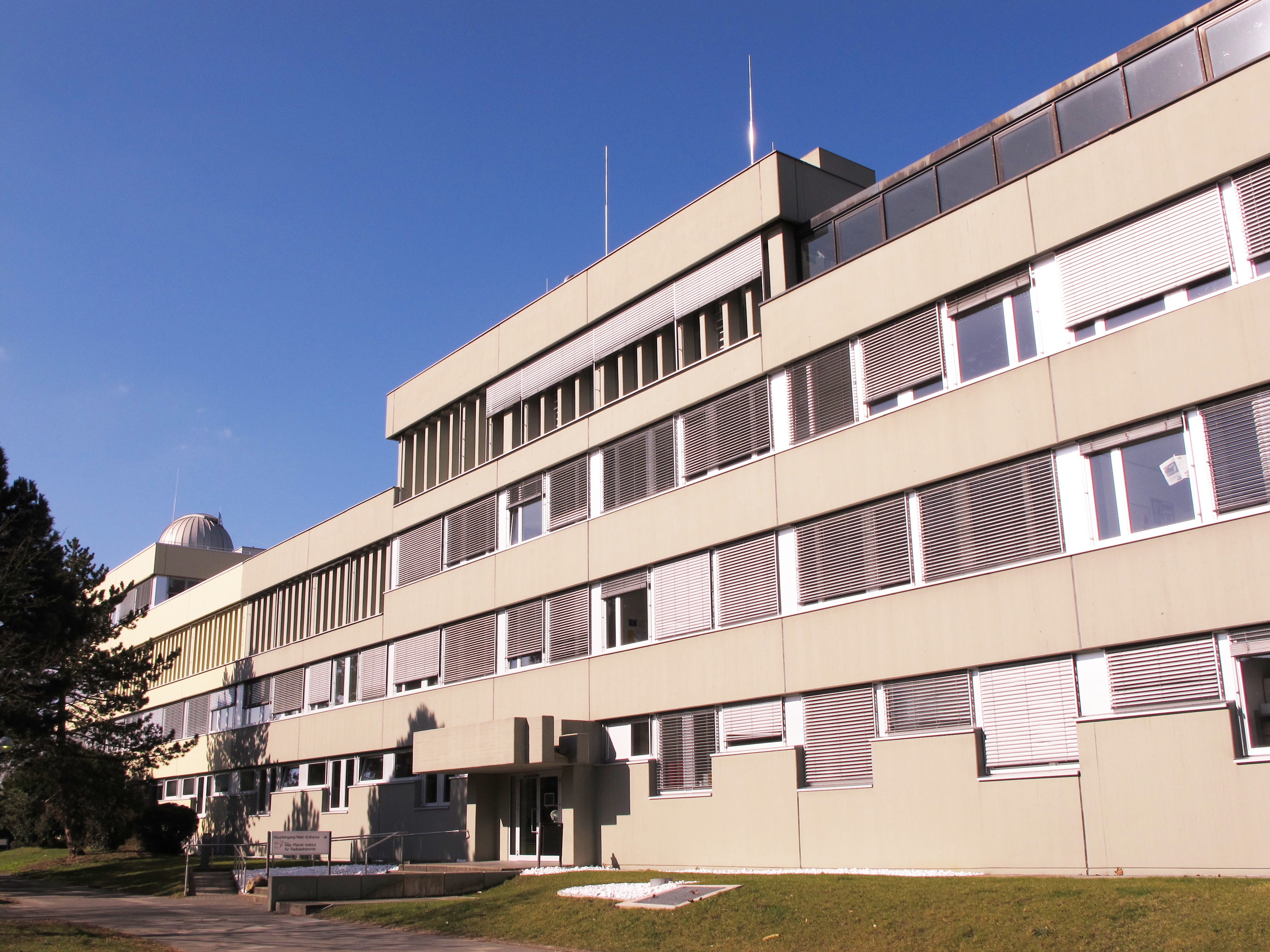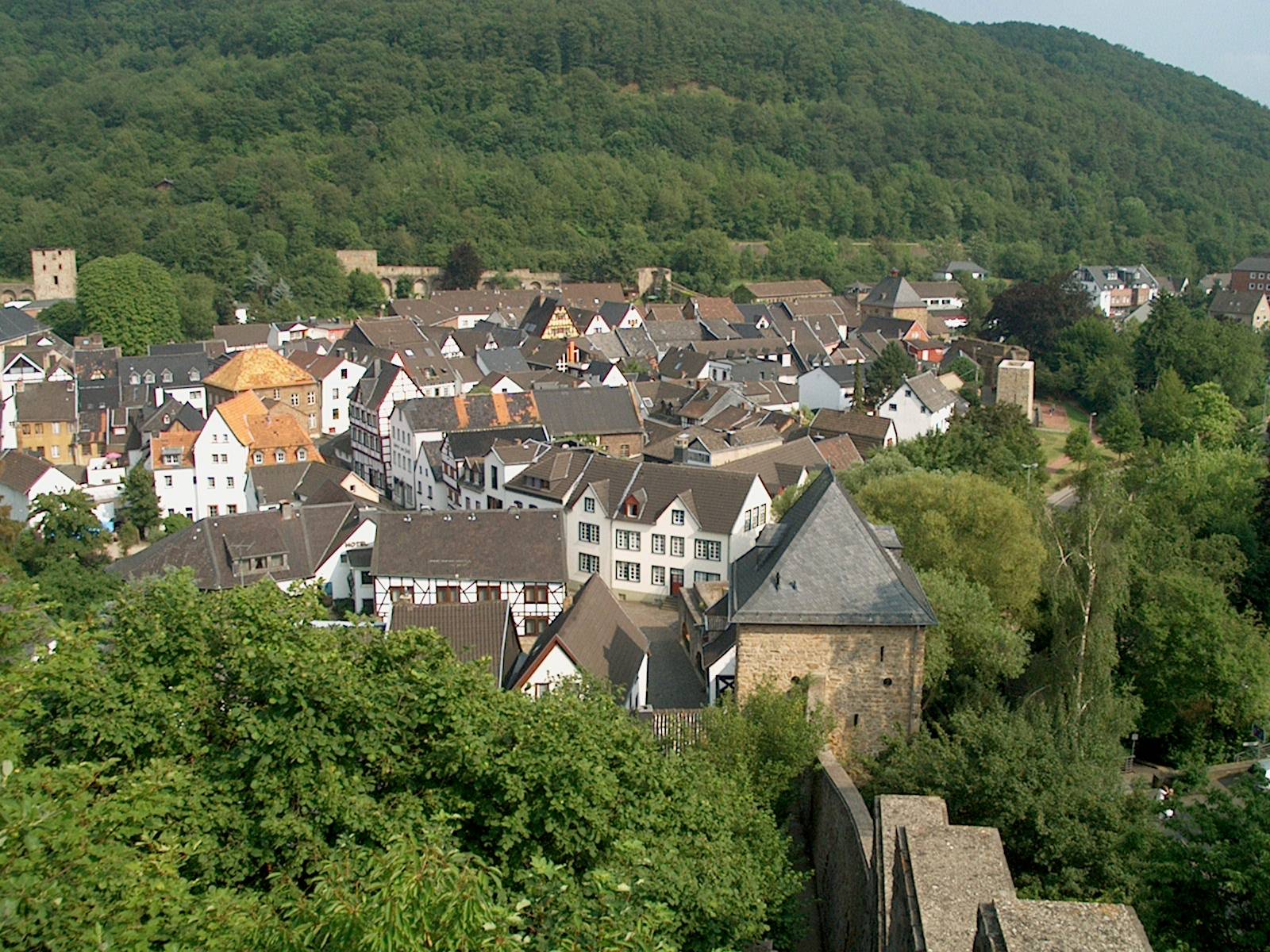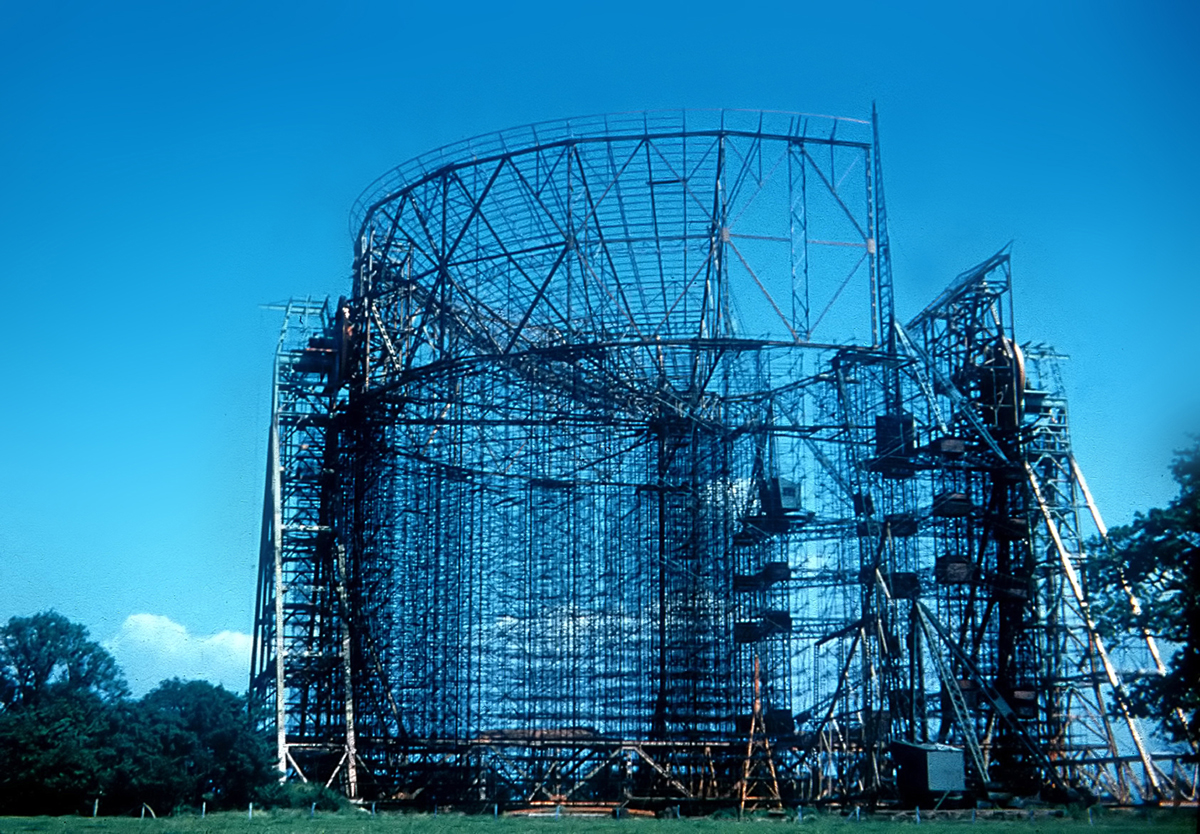|
Effelsberg
The Effelsberg 100-m Radio Telescope is a radio telescope in the Ahr Hills (part of the Eifel) in Bad Münstereifel, Germany. For 29 years the Effelsberg Radio Telescope was the largest fully steerable radio telescope on Earth, surpassing the Lovell Telescope in the UK. In 2000, it was surpassed by the Green Bank Observatory's Robert C. Byrd Green Bank Telescope in Green Bank, US, which has a slightly larger elliptical 100 by 110-metre aperture. Geography The telescope is located about 1.3 km northeast of Effelsberg, a southeastern part of the town of Bad Münstereifel in North Rhine-Westphalia. It is less than 300 m west of the 398 m high Hünerberg, which is in neighbouring Rhineland-Palatinate. The boundary is a stream, the Effelsberger Bach, which runs only a few metres east of the telescope. The Effelsberger Bach is 6.5 km long, flowing from the Effelsberger Wald into the Sahrbach, which in turn flows south and into the Ahr river. A hiking path lead ... [...More Info...] [...Related Items...] OR: [Wikipedia] [Google] [Baidu] |
Low-Frequency Array (LOFAR)
The Low-Frequency Array, or LOFAR, is a large radio telescope, with an antenna network located mainly in the Netherlands, and spreading across 7 other European countries as of 2019. Originally designed and built by ASTRON, the Netherlands Institute for Radio Astronomy, it was first opened by queen Beatrix of The Netherlands in 2010, and has since been operated on behalf of the International LOFAR Telescope (ILT) partnership by ASTRON. LOFAR consists of a vast array of omnidirectional radio antennas using a modern concept, in which the signals from the separate antennas are not connected directly electrically to act as a single large antenna, as they are in most array antennas. Instead, the LOFAR dipole antennas (of two types) are distributed in stations, within which the antenna signals can be partly combined in analogue electronics, then digitised, then combined again across the full station. This step-wise approach provides great flexibility in setting and rapidly changing the ... [...More Info...] [...Related Items...] OR: [Wikipedia] [Google] [Baidu] |
Radio Telescope
A radio telescope is a specialized antenna and radio receiver used to detect radio waves from astronomical radio sources in the sky. Radio telescopes are the main observing instrument used in radio astronomy, which studies the radio frequency portion of the electromagnetic spectrum emitted by astronomical objects, just as optical telescopes are the main observing instrument used in traditional optical astronomy which studies the light wave portion of the spectrum coming from astronomical objects. Unlike optical telescopes, radio telescopes can be used in the daytime as well as at night. Since astronomical radio sources such as planets, stars, nebulas and galaxies are very far away, the radio waves coming from them are extremely weak, so radio telescopes require very large antennas to collect enough radio energy to study them, and extremely sensitive receiving equipment. Radio telescopes are typically large parabolic ("dish") antennas similar to those employed in tracking an ... [...More Info...] [...Related Items...] OR: [Wikipedia] [Google] [Baidu] |
Radio Telescopes
A radio telescope is a specialized antenna and radio receiver used to detect radio waves from astronomical radio sources in the sky. Radio telescopes are the main observing instrument used in radio astronomy, which studies the radio frequency portion of the electromagnetic spectrum emitted by astronomical objects, just as optical telescopes are the main observing instrument used in traditional optical astronomy which studies the light wave portion of the spectrum coming from astronomical objects. Unlike optical telescopes, radio telescopes can be used in the daytime as well as at night. Since astronomical radio sources such as planets, stars, nebulas and galaxies are very far away, the radio waves coming from them are extremely weak, so radio telescopes require very large antennas to collect enough radio energy to study them, and extremely sensitive receiving equipment. Radio telescopes are typically large parabolic ("dish") antennas similar to those employed in tracking and c ... [...More Info...] [...Related Items...] OR: [Wikipedia] [Google] [Baidu] |
Ahr Hills
The Ahr HillsElkins, T.H. (1972). ''Germany'' (3rd ed.). London: Chatto & Windus, 1972. . (german: Ahrgebirge or ''Ahreifel'' ) are a range of low mountains and hills up to and long in the Eifel region of Germany, which lie roughly southwest of Bonn on the border between the German states of North Rhine-Westphalia and Rhineland-Palatinate. The forested Ahr Hills have numerous tourist destinations (e. g. Aremberg Castle and the Effelsberg Radio Telescope) and the section of a Roman road with its ancient Eifel Aqueduct. Geography Location The Ahr Hills are part of the Eifel, the bulk of which lies to the south and southwest of it. It lies on the left, i.e. northwestern, bank of the river Ahr, roughly 40 km southwest of Bonn. Sometimes the ridge on the right, southeastern, bank of the Ahr in the area of Altenahr is also counted as part of the Ahr Hills. This small range is bordered by a square enclosed by the Grafschaft and Remagen to the east, by Altenahr to the s ... [...More Info...] [...Related Items...] OR: [Wikipedia] [Google] [Baidu] |
Max Planck Institute For Radio Astronomy
The Max Planck Institute for Radio Astronomy (MPIfRA) (German: ''Max-Planck-Institut für Radioastronomie'') is located in Bonn, Germany. It is one of 80 institutes in the Max Planck Society (German: Max-Planck-Gesellschaft). History By combining the already existing radio astronomy faculty of the University of Bonn led by Otto Hachenberg with the new Max Planck institute the Max Planck Institute for Radio Astronomy was formed. In 1972 the 100-m radio telescope in Effelsberg was opened. The institute building was enlarged in 1983 and 2002. The southern wing of the whole complex is occupied by the Argelander Institute of Astronomy of the University of Bonn. Structure The Institute has three main research groups, each with its own Director Departments * Fundamental Physics ( Michael Kramer) * VLBI and Radio Astronomy ( Anton Zensus) * Millimetre Astronomy ( Karl Menten) Independent Research Groups * Lise Meitner Group on Fast Radio Bursts as Astrophysical Tools ... [...More Info...] [...Related Items...] OR: [Wikipedia] [Google] [Baidu] |
Bad Münstereifel
Bad Münstereifel () is a historical spa town in the district of Euskirchen, Germany, with about 17,000 inhabitants, situated in the far southwest of the German state of North Rhine-Westphalia. The little town is one of only a few historical towns in the southwest of North Rhine-Westphalia, and because of this is often overcrowded by tourists throughout spring and summer. Geography Location Bad Münstereifel lies about southwest of Bonn and around ten (both as the crow flies) south of the county town of Euskirchen in the Münstereifel Forest, a part of the Eifel mountains. The River Erft flow through the town. It has a borough of around in area at heights of above sea level. The latter is the height of the Michelsberg, which is the highest point in the borough and rises in the northwestern part of the Ahr Hills (another region of the Eifel). The borough is around 60 percent forested, several woods are designated as so-called ancient forest (''Urwald''). Over of tra ... [...More Info...] [...Related Items...] OR: [Wikipedia] [Google] [Baidu] |
Lovell Telescope
The Lovell Telescope is a radio telescope at Jodrell Bank Observatory, near Goostrey, Cheshire in the north-west of England. When construction was finished in 1957, the telescope was the largest steerable dish radio telescope in the world at 76.2 m (250 ft) in diameter; it is now the third-largest, after the Green Bank Telescope, Green Bank telescope in West Virginia, United States, and the Effelsberg 100-m Radio Telescope, Effelsberg telescope in Germany. It was originally known as the "250 ft telescope" or the Radio Telescope at Jodrell Bank, before becoming the Mark I telescope around 1961 when future telescopes (the Mark II (radio telescope), Mark II, Mark III (radio telescope), III, and IV) were being discussed.Lovell, ''The Jodrell Bank Telescopes'' It was renamed to the Lovell Telescope in 1987 after Sir Bernard Lovell, and became a Grade I listed building in 1988. The telescope forms part of the MERLIN and European VLBI Network arrays of radio telescopes. Both ... [...More Info...] [...Related Items...] OR: [Wikipedia] [Google] [Baidu] |
Green Bank Telescope
The Robert C. Byrd Green Bank Telescope (GBT) in Green Bank, West Virginia, US is the world's largest fully steerable radio telescope, surpassing the Effelsberg 100-m Radio Telescope in Germany. The Green Bank site was part of the National Radio Astronomy Observatory (NRAO) until September 30, 2016. Since October 1, 2016, the telescope has been operated by the independent Green Bank Observatory. The telescope's name honors the late Senator Robert C. Byrd who represented West Virginia and who pushed the funding of the telescope through Congress. The Green Bank Telescope operates at meter to millimeter wavelengths. Its 100-meter diameter collecting area, unblocked aperture, and good surface accuracy provide superb sensitivity across the telescope's full 0.1–116 GHz operating range. The GBT is fully steerable, and 85 percent of the local celestial hemisphere is accessible. It is used for astronomy about 6500 hours every year, with 2000–3000 hours per year going to high-fr ... [...More Info...] [...Related Items...] OR: [Wikipedia] [Google] [Baidu] |
Krupp
The Krupp family (see pronunciation), a prominent 400-year-old German dynasty from Essen, is notable for its production of steel, artillery, ammunition and other armaments. The family business, known as Friedrich Krupp AG (Friedrich Krupp AG Hoesch-Krupp after acquiring Hoesch AG in 1991 and lasting until 1999), was the largest company in Europe at the beginning of the 20th century, and was the premier weapons manufacturer for Germany in both world wars. Starting from the Thirty Years' War until the end of the Second World War, it produced battleships, U-boats, tanks, howitzers, guns, utilities, and hundreds of other commodities. The dynasty began in 1587 when trader Arndt Krupp moved to Essen and joined the merchants' guild. He bought and sold real estate, and became one of the city's richest men. His descendants produced small guns during the Thirty Years' War and eventually acquired fulling mills, coal mines and an iron forge. During the Napoleonic Wars, Friedrich Kr ... [...More Info...] [...Related Items...] OR: [Wikipedia] [Google] [Baidu] |
Stockert Radio Telescope
__NOTOC__ The Stockert Radio Telescope is a historical radio telescope in the Eifel mountain range in Germany, situated 12 km from the Effelsberg 100-m Radio Telescope. Radio telescope Germany's first telescope for radio astronomy, with a diameter of 25 m, was inaugurated on 17 September 1956 on the Stockert. Until 1995 – since 1979 only for student training – it was used by the University of Bonn and the Max Planck Institute for Radio Astronomy. Between 1997 and 2004, the telescope was owned by the digital audio company Creamware and used for inspirational purposes and as a location for their musical festivals called ''Woodstockert''. In 1999 the installation was listed for its industrial heritage, and since 2005 it is owned by the Nordrhein-Westfalen-Stiftung (NRW-Stiftung), which in 2006 made available €300,000 for restoration. The site is used and taken care of by the Astropeiler Stockert e.V., which has updated the technology and has opened the site to the ... [...More Info...] [...Related Items...] OR: [Wikipedia] [Google] [Baidu] |
1971 Establishments In West Germany
* The year 1971 had three partial solar eclipses (February 25, July 22 and August 20) and two total lunar eclipses (February 10, and August 6). The world population increased by 2.1% this year, the highest increase in history. Events January * January 2 – 66 people are killed and over 200 injured during a crush in Glasgow, Scotland. * January 5 – The first ever One Day International cricket match is played between Australia and England at the Melbourne Cricket Ground. * January 8 – Tupamaros kidnap Geoffrey Jackson, British ambassador to Uruguay, in Montevideo, keeping him captive until September. * January 9 – Uruguayan president Jorge Pacheco Areco demands emergency powers for 90 days due to kidnappings, and receives them the next day. * January 12 – The landmark United States television sitcom ''All in the Family'', starring Carroll O'Connor as Archie Bunker, debuts on CBS. * January 14 – Seventy Brazilian political prisoners are release ... [...More Info...] [...Related Items...] OR: [Wikipedia] [Google] [Baidu] |
Antenna Feed
A radio transmitter or receiver is connected to an antenna which emits or receives the radio waves. The antenna feed system or antenna feed is the cable or conductor, and other associated equipment, which connects the transmitter or receiver with the antenna and makes the two devices compatible. In a radio transmitter, the transmitter generates an alternating current of radio frequency, and the feed system feeds the current to the antenna, which converts the power in the current to radio waves. In a radio receiver, the incoming radio waves excite tiny alternating currents in the antenna, and the feed system delivers this current to the receiver, which processes the signal. To transfer radio frequency current efficiently, the ''feedline'' connecting the transmitter or receiver to the antenna must be a special type of cable called transmission line. At microwave frequencies, waveguide is often used, which is a hollow metal pipe carrying radio waves. In a parabolic (dish) ... [...More Info...] [...Related Items...] OR: [Wikipedia] [Google] [Baidu] |


.jpg)








